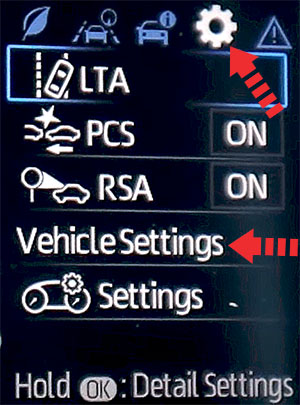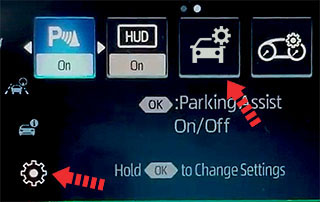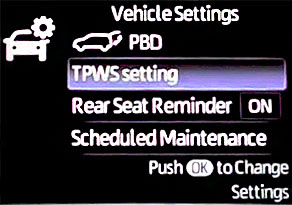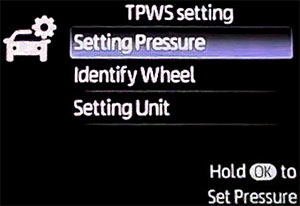Toyota Venza is equipped with Tire Pressure Monitoring System (TPMS) for the purpose of warning the driver when one or more of the tires are significantly under-inflated, creating a potentially unsafe driving condition. In this article we discuss the reasons for the amber colored TPMS warning light in Venza, and how you can reset it.

The TPMS warning light illuminates in Toyota Venza when air pressure is low in one or more of the tires, battery has depleted in a pressure sensor, TPMS receiver module has malfunctioned, or a pressure sensor has been damaged.
Low tire pressure
When the amber colored TPMS warning light  turns on in your Venza, stop your vehicle when it is safe to do so and check tire pressure on all the wheels, including the spare wheel (if your vehicle has one). Driving on a significantly under-inflated tire causes the tire to overheat and can lead to tire failure.
turns on in your Venza, stop your vehicle when it is safe to do so and check tire pressure on all the wheels, including the spare wheel (if your vehicle has one). Driving on a significantly under-inflated tire causes the tire to overheat and can lead to tire failure.

Reinflate the tires
Reinflate all the tires of your Venza to the manufacturer specified air pressure, which is mentioned on the vehicle placard or tire inflation pressure label usually located on the B-pillar or the edge of the driver door. If you can’t find the label, check the size of your tire which is mentioned on the sidewall of the tire, and match it to the tire pressure information shown below. These are official cold tire pressure values for Venza from Toyota.
- 225/60R18 100H: 33 psi (230 kPa, 2.3 or bar)
- 225/55R19 99V: 33 psi (230 kPa, 2.3 or bar)
- T165/80R17 104M (spare tire): 60 psi (420 kPa, 4.2 bar)

Resetting the TPMS warning light
After you have inflated all the tires to the correct air pressure, the TPMS warning light should turn off automatically after driving for a few miles. Toyota Venza uses the direct method for monitoring tire pressure, which means a pressure sensor actively records the internal pressure of the tire on each wheel. If the warning light doesn’t turn off you should perform a reset procedure from the instrument cluster settings.
The tire pressure warning system must be initialized in the following circumstances:
- When rotating the tires.
- When changing the tires.
- After registering the ID codes.
- When changing between two registered wheel sets.
When the tire pressure warning system is initialized, the current tire inflation pressure is set as the benchmark pressure.
TPMS reset procedure in Toyota Venza
- Park the vehicle in a safe place and stop the hybrid system for 20 minutes or more.
Note: Initialization cannot be performed while the vehicle is moving. - Adjust the tire inflation pressure to the specified cold tire inflation pressure level.
Note: Make sure to adjust the tire pressure to the specified cold tire inflation pressure level. The tire pressure warning system will operate based on this pressure level. - Start the hybrid system.
- Select the settings tab
 in the instrument cluster display using steering wheel controls.
in the instrument cluster display using steering wheel controls. - 4.2-inch display: Select “Vehicle Settings”.

7-inch display: Select vehicle settings icon and then hold the OK button.
and then hold the OK button.
- Select “TPWS setting”.

- Select “Setting Pressure”, and then press and hold the OK button on the steering wheel.

- “Set Pressure Accepted” will be displayed on the multi-information display and the tire pressure warning light will blink 3 times. When the message disappears, initialization is complete.
- Also, “- – -” is displayed for inflation pressure of each tire on the multi-information display while the tire pressure warning system determines the position.
- Drive straight (with occasional left and right turns) at approximately 25mph (40 km/h) or more for approximately 10 to 30 minutes.
- When initialization is complete, the inflation pressure of each tire will be displayed on the multi-information display.
WARNING! Do not initialize tire inflation pressure without first adjusting the tire inflation pressure to the specified level. Otherwise, the tire pressure warning light may not come on even if the tire inflation pressure is low, or it may come on when the tire inflation pressure is actually normal.
Even if the vehicle is not driven at approximately 25 mph (40 km/h) or more, initialization can be completed by driving for a long time. However, if initialization does not complete after driving for 1 hour or more, park the vehicle in a safe place for approximately 20 minutes and then drive the vehicle again.
If the low tire pressure light does not turn off automatically after reinflating the tires in your Venza, increase the tire pressure by 5 psi on top of the factory recommended value, and drive your vehicle for at least 10 miles (16 km). After the TPMS warning light turns off, and the vehicle has been parked for a few hours, reduce the tire pressure to the factory recommended value.
Chilly weather can turn on low tire pressure light in Venza
Cold weather is one of the most common cause for low tire pressure warning light in Toyota Venza. When analyzing WheelsJoint’s statistical data, it has been observed that there is sharp rise in the number of searches for TPMS warning light causes at the start of every winter season, about three times higher as compared to mid summer season.

The air, like most other substances, expands when heated and contracts when cooled. So when the weather gets colder, the tire pressure decreases, which could trigger TPMS warning light in Venza. The tire pressure will vary with temperature by about 1 psi (7 kPa) for every 12°F (6.5°C).

Inflate tires when cold
Tire pressure in Venza should always be set based on cold inflation tire pressure. This is defined as the tire pressure after the vehicle has not been driven for at least three hours, or driven less than 1 mile (1.6 km) after a three-hour period.
Do not adjust tire pressure when hot
The tires on your Venza can get around 50 degrees hotter than the outside temperature when you’re driving, which increases the tire pressure by about 4 psi – this is normal and there should be no adjustment for this increased pressure.
Does altitude affect tire pressure?
Yes, altitude can change tire pressure values, but it is negligible and not a cause for concern. If you drive your Venza from sea level to Mount Evans Scenic Byway in Colorado which is the highest paved road in North America at the altitude of 14,130 feet (4,307 m), the tire pressure should theoretically increase by approximately 6 psi. But, the decrease in ambient temperature at higher elevation contracts the air in tires and compensates for any altitude pressure changes.
Is it safe to drive Venza with low tire pressure?
The driving characteristics of Venza change even if the air pressure is 5 psi less than manufacturer’s recommended value: the braking distance can be longer, cornering worse, and at particularly high speeds there is even a risk that the tire will burst. Low tire pressure also increases tire wear, and the higher rolling resistance of the tire means higher fuel consumption. So it is recommended to reinflate the tires to the correct pressure as soon as possible.
Dead battery in a tire pressure sensor
Each tire pressure sensor in Venza is powered by a built-in lithium-ion battery. When the battery is depleted, the sensor stops transmitting tire pressure information to the receiver module. When this happens, the TPMS warning light will flash every time the engine is started, and will remain illuminated until you turn off the vehicle.

How long do the pressure sensor batteries last?
The tire pressure sensor batteries usually last anywhere from 5 to 10 years in Venza. When the battery is depleted, you must replace the sensor itself, as the battery is sealed into the sensor unit and is non-replaceable.
Identifying a faulty pressure sensor
The most reliable method for detecting a faulty tire pressure sensor or a sensor with dead battery is by testing each sensor with a scan tool. For example, MaxiTPMS TS408 is commonly used for diagnosing and programming tire pressure sensors. A sensor that is not detectable by the scanner is most likely defective and should be replaced with a new one.

If you don’t want to spend over a hundred bucks on a scanner, then head over to any reputable tire shop and perform a TPMS diagnostic scan of your Venza. Some shops like Discount Tire and Pep Boys offer free of charge TPMS diagnostic services.
Installed new tires?
If a pressure sensor stopped responding after you installed new tires on your Venza, it is possible the sensor got damaged during tire installation. These sensors are quite sensitive, and can be easily damaged if utmost care is not taken while changing tires.
Toyota Venza TPMS user guide
Your vehicle is equipped with a tire pressure warning system that uses tire pressure warning valves and transmitters to detect low tire inflation pressure before serious problems arise.
The tire pressure detected by the tire pressure warning system can be displayed on the multi-information display. The unit can be changed.
TPMS warning types in Venza
The tire pressure warning system of this vehicle adopts a 2- type warning system.
- When “Adjust Pressure” is displayed (Normal Warning): The tire pressure warning light comes on and a buzzer sounds when the tire inflation pressure becomes low due to natural air leakage or outside temperature.
- When “Immediately Check tire when Safe” is displayed (Emergency Warning): The tire pressure warning light comes on and a buzzer sounds when the tire inflation pressure becomes low suddenly due to a blowout. However, the system may not be able to detect sudden tire ruptures (bursting, etc.).
TPMS reset guidelines
- Initialization is performed while driving at a vehicle speed of approximately 25 mph (40 km/h) or more.
- Make sure to carry out initialization after adjusting the tire inflation pressure. Also, make sure the tires are cold before carrying out initialization or tire inflation pressure adjustment.
- The tire pressure warning system can be initialized by yourself, but depending on the driving conditions and driving environment, initialization may take some time to complete.
- If you have accidentally turned the power switch to OFF during initialization, it is not necessary to restart the initialization again as initialization will restart automatically when the power switch has been turned to ON for the next time.
- If you accidentally perform initialization when initialization is not necessary, adjust the tire inflation pressure to the specified level when the tires are cold, and conduct initialization again.
- While the position of each tire is being determined and the inflation pressures are not being displayed on the multi-information display, if the inflation pressure of a tire drops, the tire pressure warning light will come on.
If the tire pressure warning system is not initialized/reset properly
In the following situations, initialization may take longer than usual to be completed or may not be possible. Normally, initialization completes within approximately 30 minutes.
- Vehicle is not driven at approximately 25 mph (40 km/h) or more.
- Vehicle is driven on unpaved roads.
- Vehicle is driven near other vehicles and system cannot recognize tire pressure warning valve and transmitters of your vehicle over those of other vehicles.
- If the vehicle is driven in heavy traffic or another situation where other vehicles are driven close by, it may take time for the system to recognize the tire pressure warning valve and transmitters of your vehicle over those of other vehicles.
If initialization does not complete after driving for 1 hour or more, park the vehicle in a safe place for approximately 20 minutes and then drive the vehicle again.
If the vehicle is reversed during initialization, the data up to that point is reset, so perform the initialization procedure again from the beginning.
In the following situations, initialization will not be started or was not completed properly and the system will not operate properly. Perform the initialization procedure again.
- If, when attempting to start initialization, the tire pressure warning light does not blink 3 times.
- If, when the vehicle has been driven for about 20 minutes after performing initialization, the tire pressure warning light blinks for approximately 1 minute and then illuminates.
If initialization cannot be completed after performing the above procedure, contact your Toyota dealer.
How to change the tire pressure unit
- Park the vehicle in a safe place and turn the power switch off.
Note: Changing the unit cannot be performed while the vehicle is moving. - Turn the power switch to ON.
- Select the settings tab
 in the instrument cluster display using the steering wheel controls.
in the instrument cluster display using the steering wheel controls. - 4.2-inch display: Select “Vehicle Settings”.
7-inch display: Select vehicle settings icon and then press OK.
and then press OK. - Select “TPWS setting”.
- Select “Setting Unit”.
- Select your desired unit and press OK.
Registering ID codes
Every tire pressure warning valve and transmitter has a unique ID code. When replacing a tire pressure warning valve and transmitter, it is necessary to register the ID code. When registering the ID codes, perform the following procedure.
- Park the vehicle in a safe place and stop the hybrid system for 20 minutes or more.
- Select the settings tab
 in the instrument cluster display using the steering wheel controls.
in the instrument cluster display using the steering wheel controls. - 4.2-inch display: Select “Vehicle Settings”.
7-inch display: Select vehicle settings icon and then press OK.
and then press OK. - Select “TPWS setting”.
- Select “Identify Wheel”, and then press and hold the OK button until the tire pressure warning light starts slowly blinking 3 times.
- The change wheel set mode is activated and registration is started. Then a message will be displayed on the multi-information display. When registration is being performed, the tire pressure warning light will blink for approximately 1 minute then illuminate and “- – -” will be displayed for the inflation pressure of each tire on the multi-information display.
- Drive straight (with occasional left and right turns) at approximately 25mph (40 km/h) or more for approximately 10 to 30 minutes.
- Initialize the tire pressure warning system.
When registration is completed, the tire pressure warning light will go off and the inflation pressure of each tire will be displayed on the multiinformation display.
Even if the vehicle is not driven at approximately 25 mph (40 km/h) or more, registration can be completed by driving for a long time. However, if registration does not complete after driving for 1 hour or more, perform the procedure again from the beginning.
When registering ID codes
- ID code registration is performed while driving at a vehicle speed of approximately 25 mph (40 km/h) or more.
- Before performing ID code registration, make sure that no wheels with tire pressure warning valve and transmitters installed are near the vehicle.
- Make sure to initialize the tire pressure warning system after registering the ID codes. If the system is initialized before registering the ID codes, the initialized values will be invalid.
- ID codes can be registered by yourself, but depending on the driving conditions and driving environment, registration may take some time to complete.
- As the tires will be warm when registration is completed, make sure to allow the tires to cool before performing initialization.
Canceling ID code registration
- To cancel ID code registration after it has been started, select “Identify Wheel” on the multi-information display and press and hold the OK button again.
- If ID code registration has been canceled, the tire pressure warning light will blink for approximately 1 minute when the power switch is turned to ON and then illuminate. The tire pressure warning system will be operational when the tire pressure warning light turns off.
- If the warning light does not turn off even after several minutes have elapsed, ID code registration may not have been canceled correctly. To cancel registration, perform the ID code registration start procedure again and then turn the power switch off before driving.
If ID codes are not registered properly
In the following situations, ID code registration may take longer than usual to be completed or may not be possible. Normally, registration completes within approximately 30 minutes. If ID code registration is not complete after driving for approximately 30 minutes, continue driving for a while.
- Vehicle is not parked for approximately 20 minutes or more before driving.
- Vehicle is not driven at approximately 25 mph (40 km/h) or more.
- Vehicle is driven on unpaved roads.
- Vehicle is driven near other vehicles and system cannot recognize tire pressure warning valve and transmitters of your vehicle over those of other vehicles.
- Wheel with tire pressure warning valve and transmitter installed is inside or near the vehicle
If registration does not complete after driving for 1 hour or more, perform the ID code registration procedure again from the beginning.
If the vehicle is reversed during registration, the data up to that point is reset, so perform the registration procedure again from the beginning.
In the following situations, ID code registration will not be started or was not completed properly and the system will not operate properly. Perform the ID code registration procedure again.
- If, when attempting to start ID code registration, the tire pressure warning light does not blink slowly 3 times.
- If, when the vehicle has been driven for about 20 minutes after performing ID code registration, the tire pressure warning light blinks for approximately 1 minute and then illuminates.
If ID code registration cannot be completed after performing the above procedure, contact your Toyota dealer.
Selecting wheel set
Your vehicle is equipped with tire pressure warning system with the function to have ID codes registered for a second wheel set, for example a winter set. You can register a second wheel set by yourself or your Toyota dealer.
After registration of a second wheel set, either of these two wheel sets can be selected for usage with the tire pressure warning system.
This function will perform the change of wheel set only if a second wheel set has been registered. If no second wheel set has been registered, no change will be made when selecting this function in the menu.
Only a change between both registered wheel set is possible, mixing between these wheel sets is not supported.
How to change between wheel sets
- Have the vehicle fitted with the preferred wheel set.
- Select the settings tab
 in the instrument cluster display using the steering wheel controls.
in the instrument cluster display using the steering wheel controls. - 4.2-inch display: Select “Vehicle Settings”.
7-inch display: Select vehicle settings icon and then press OK.
and then press OK. - Select “TPWS setting”.
- Select “Identify Wheel”, and then press and hold the OK button until the tire pressure warning light starts slowly blinking 3 times.
- Afterward, the tire pressure warning light turns on after flashing for 1 minute.
- After 2 minutes, registration of a second wheel set is being performed. The tire pressure warning light will turn off and “–” will be displayed for the inflation pressure of each tire on the multi-information display.
- Initialize/reset the tire pressure warning system.
Note: If the tire inflation pressure settings for the installed tires change, initialization operations are required, but if the tire inflation pressure settings are the same, initialization is not required. - Drive straight (with occasional left and right turns) at approximately 25 mph (40 km/h) or more for approximately 10 to 30 minutes.
- Registration of a second wheel set is complete when the tire pressure warning light turns off and the inflation pressure of each tire is displayed on the multi-information display.
Routine tire inflation pressure checks
The tire pressure warning system does not replace routine tire inflation pressure checks. Make sure to check tire inflation pressure as part of your routine of daily vehicle checks.
Replacing tire pressure warning valves and transmitters
Because tire repair or replacement may affect the tire pressure warning valves and transmitters, make sure to have tires serviced by your Toyota dealer or other qualified service shop. In addition, make sure to purchase your tire pressure warning valves and transmitters at your Toyota dealer. Ensure that only genuine Toyota wheels are used on your vehicle. Tire pressure warning valves and transmitters may not work properly with non-genuine wheels.
Tire inflation pressure
It may take a few minutes to display the tire inflation pressure after the power switch is turned to ON. It may also take a few minutes to display the tire inflation pressure after inflation pressure has been adjusted. Tire inflation pressure changes with temperature. The displayed values may also be different from the values measured using a tire pressure gauge.
Situations in which the tire pressure warning system may not operate properly
In the following cases, the tire pressure warning system may not operate properly.
- If non-genuine Toyota wheels are used.
- A tire has been replaced with a tire that is not an OE (Original Equipment) tire.
- A tire has been replaced with a tire that is not of the specified size.
- Tire chains, etc. are equipped.
- An auxiliary-supported run-flat tire is equipped.
- If a window tint that affects the radio wave signals is installed.
- If there is a lot of snow or ice on the vehicle, particularly around the wheels or wheel housings.
- If the tire inflation pressure is extremely higher than the specified level.
- If wheels without tire pressure warning valves and transmitters are used.
- If the ID code on the tire pressure warning valves and transmitters is not registered in the tire pressure warning computer.
Performance may be affected in the following situations.
- Near a TV tower, electric power plant, gas station, radio station, large display, airport or other facility that generates strong radio waves or electrical noise.
- When carrying a portable radio, cellular phone, cordless phone or other wireless communication device.
If tire position information is not correctly displayed due to the radio wave conditions, the display may be corrected by driving and changing the radio wave conditions.
When the vehicle is parked, the time taken for the warning to start or go off could be extended.
When tire inflation pressure declines rapidly for example when a tire has burst, the warning may not function.
Warning performance of the tire pressure warning system
The warning of the tire pressure warning system will change in accordance with the conditions under which it was initialized. For this reason, the system may give a warning even if the tire pressure does not reach a low enough level, or if the pressure is higher than the pressure that was adjusted to when the system was initialized.
Installing tire pressure warning valves and transmitters
When replacing tires or wheels, tire pressure warning valves and transmitters must also be installed. When new tire pressure warning valves and transmitters are installed, new ID codes must be registered in the tire pressure warning computer and the tire pressure warning system must be initialized.
If the ID code of the tire pressure warning valve and transmitter is not registered, the tire pressure warning system will not work properly. After driving for about 20 minutes, the tire pressure warning light blinks for 1 minute and stays on to indicate a system malfunction.
Repairing or replacing tires, wheels, tire pressure warning valves, transmitters and tire valve caps
- When removing or fitting the wheels, tires or the tire pressure warning valves and transmitters, contact your Toyota dealer as the tire pressure warning valves and transmitters may be damaged if not handled correctly.
- Make sure to install the tire valve caps. If the tire valve caps are not installed, water could enter the tire pressure warning valves and the tire pressure warning valves could be bound.
- When replacing tire valve caps, do not use tire valve caps other than those specified. The cap may become stuck.
Tire pressure keeps getting low
If the TPMS warning light turns on frequently in your Venza, and the tire pressure is also decreasing after you have reinflated the tires, there may be an air leak. One or more of the tires may have been punctured by an external object, or the air may be leaking from a defective value stem.

Can I disable the TPMS system in Venza?
No, the TPMS system is federally mandated, and cannot be disabled in Toyota Venza. All vehicles must have a working tire pressure monitoring system to be legally compliant.
Use OBD2 scanner for diagnosis
Since Toyota Venza is equipped with on-board diagnostics (OBD), a fault diagnosis can provide initial indications of where the malfunction is located. But when it comes to TPMS, a basic code reader will not suffice. You will need an advanced scanner to monitor TPMS data or read TPMS codes.

BlueDriver is a commonly used scanner by DIYers that can read TPMS codes for most vehicles and isn’t too expensive – costs about a hundred bucks. You can also clear the TPMS fault codes with this device which will turn off the warning light, but the light may come back on if the on-board diagnostic system detects a fault again.


